A Sherpa has died in the IceFall near the Football Field. He apparently just collapsed as there was no fall, illness, or avalanche. Teams are starting to stock the higher camps with tents, food, and fuel getting ready for the first rotations.
Big Picture
Teams on Everest have already begun the acclimatization process. It usually begins with a short trip halfway up the Khumbu Icefall to an area called, the ‘Football field.’ This is a relatively flat section, somewhat safe from avalanches from Everest’s West Shoulder. Climbers will be very slow on this first climb as they are not fully acclimatized. They will be hurting puppies!
Everest
Nima Tenji Sherpa, a Sherpa with IMG, has reportedly died while carrying loads in the Khumbu Icefall. He was one of 11 Sherpas going higher to stock Camp 1. My sincere condolences to his family, friends, and teammates. IMG posted this update:
Yesterday we had our first big carry of gear going uphill to Camps 1 and 2, and our lead team of Sherpas are now up at Camp 2 building that camp. Partway up the Icefall, near the “football field”, one of our Sherpas, Ngima Tenji, collapsed and was found sitting next to the trail still wearing his backpack, lifeless. There was no fall, avalanche, or trauma involved. Ngima was 38 years old, had worked for IMG for many years and is a multiple Everest summiter. He had been doing fine, so this was apparently some medical issue. Ngima’s remains were flown off the mountain by helicopter.
IMG’s Team 1 is now down at Lobuche Peak preparing for their acclimatization climb, and Team 2 will descend tomorrow to Lobuche as well. The expedition had been going well for our IMG teams, so the events today have been a big shock to everyone. Our thoughts and prayers are with Ngima’s family in Waku (below Lukla), as well as with the rest of our IMG climbers and Sherpas.
Stu Peacock the leader of the Adventure Peaks team reports on their first trip into the Icefall:
Today the team made its first journey into the famous Khumbu icefall up to 5500m. No ladders were encountered on this outing, but we expect to be challenged higher up. The team were able to get plenty of practice moving on fixed lines. We were back in time for another cracking lunch prepared by Gyanu. The route to camp 2 has now been fixed, so once we’ve had our puja on Thursday, the Sherpas will push ahead setting up camps 1 & 2. The team is making excellent progress and is currently ahead of schedule, they will now aim to touch camp 1 on Friday before returning to base camp the same day.
AAI, IMG, Madison Mountaineering, and more have all arrived at Everest Base Camp. Almost all the other teams are trekking and will arrive in a day or so. See the tracking table for your favorite team
Arriving at Everest Base Camp is a huge milestone for most climbers. While they may have trekked there, this time is entirely different. They are not visitors, they are residents for the next six weeks.
The Beginning – Everest Base Camp
Oh my. Today we actually get to Everest Base Camp. It’s not that far. Gorak Shep is 5,164-meters/16,942-feet and EBC is at 5,380-meters/17,600-feet, “only” a gain of 440-meters/1,393-feet over 11.3 km/7 miles. From now on, distance is not measured in miles or kilometers but in time.
The teahouse at Gorak was unremarkable, but it might be a “vacation” for many Everest climbers seeking a bit of a respite from base camp. Yes, this is a new reality.
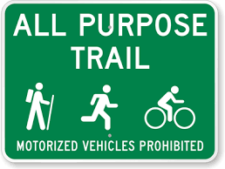 The trail is once again, familiar. Up and down, well-trodden dirt, almost impossible to get lost. Now it follows the top of a dirt path carved out by the glacier. When you pause and think about it, it’s impressive that at one time a wall of ice carved out the gully to your right, and today it is gone.
The trail is once again, familiar. Up and down, well-trodden dirt, almost impossible to get lost. Now it follows the top of a dirt path carved out by the glacier. When you pause and think about it, it’s impressive that at one time a wall of ice carved out the gully to your right, and today it is gone.
The trail is narrow at times. You need to share with people going lower, those higher, yaks, and more.
As you trek, you begin to feel the altitude. This is no longer a joke. Now there is literally 50% less oxygen in every breath. Your pace slows and the idle chatter disappears. The path is not difficult, not a lot of ups and downs but it steadily gains elevation.
If you are a climber, your adrenaline increases. If you are a trekker, your adrenaline increases. No matter if this is your first time or 25th trip, there is something magical about reaching Everest Base Camp.
The Khumbu Icefall looms large. It is steeped in rich history. When George Mallory was scouting routes, he saw the Khumbu Icefall and declared it “unclimbable.” Today it stands as the largest objective danger when climbing from the Nepal side. Speaking of Mallory, his body was found in 1999 yet his partner Sandy Irvine has not, even though a team in 2019 searched for him, and the camera. The rumor is that the Chinese found Irvine, and the camera, decades ago, and hid them from the world wanting to keep their record clean for the first ascent on the Tibet side. Who really knows, well, someone does.
You take more steps along the trail knowing the end is near. It’s a funny mixture of emotions. For those who have been planning this trek for years, it is the end. For those climbing Everest, it is just the beginning. Both perspectives yield strong emotions.
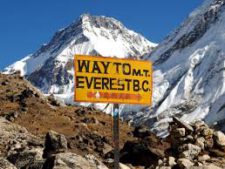 A sign takes the edge off and reduces your emotions that Nepal has turned Everest into a Disneyland attraction but then you look beyond. There are countless yellow and green tents spread over the glacier. The Icefall looms above, Nuptse to the right, Pumori to the left. In the middle of your moment, yak bells disturb your survey. You step aside.
A sign takes the edge off and reduces your emotions that Nepal has turned Everest into a Disneyland attraction but then you look beyond. There are countless yellow and green tents spread over the glacier. The Icefall looms above, Nuptse to the right, Pumori to the left. In the middle of your moment, yak bells disturb your survey. You step aside.
Now the trail goes lower. You follow it and the endless stream of porters, Sherpas, trekkers, and climbers, Yes this is a busy place, perhaps 600 this year. It’s a lot but not a record for Everest. You see, for every foreigner with a permit, 250 thus far, there is at least one support Sherpa and then there are the support staff – cooks, water boys, toilet guys, yak herders, and more. Yes, it has become an industry to get a few hundred people to the top of the world each spring. Everest, Inc. The mighty Everest Industrial Complex, some might say.
Another step and a left turn, then right. There is a rock wall blocking our path to this camp – how unfriendly! Yet soon you will understand it’s not for humans but for wandering yaks, You search for your camp. They all look alike. And random names on the banners that lack originality. There is Nepal Adventures, Nepal Treks, Nepal Climbing, Everest Summits, Everest Climbs, 8000 Meter Treks and more variations on the words: Everest, Treks, Adventure, and … whatever you can associate with climbing. Sigh.
Finally, you hear your name called out. He is one of your Sherpas from the trek that bolted ahead. You wave and smile. It’s a good feeling. Now you climb a short steep trail to a city of blue tents.
“Namaste!” you hear over and over with huge smiles.
You are home.
You made it to your new home for the next six weeks. Yesterday, the climbing Sidar, the base camp manager, cook, and other people who run the place came to greet you. Everyone is happy, friendly, and professional. You felt good, but those first few hours were a shock.
You found your tent, and it was the fourth orange one in a row of seven orange tents. All lined up perfectly as if someone had used a laser pointer. This shelter will be your tent. You will share a tent at the high camps. Yet, somehow, your two duffle bags – the red and black ones – were already next to your shelter. How did they know? This experience is the first of many mysteries you’ll witness during an Everest expedition.
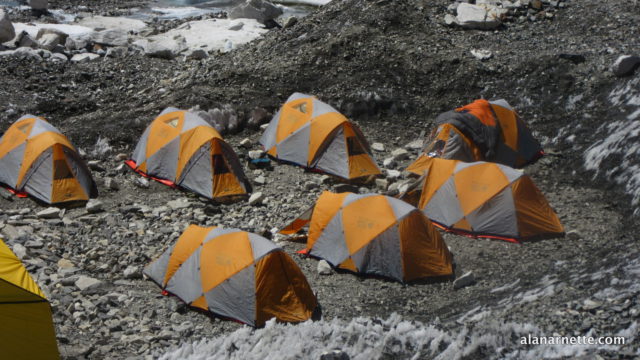
You sling your day pack off your shoulder and let it fall to the rocky ground. As your eyes followed your pack, you looked carefully at the “ground.” It was a layer of dirt and rocks on top of the ice. Then you remember, you are standing on the Khumbu Glacier.
Looking up, the Khumbu Icefall comes into focus. “Man, that thing is huge.” you say to no one in particular. The 609-meter/2,000-foot expanse of moving ice rests gently between the flanks of Nuptse and the West Shoulder of Everest. Looking at the shoulder, you search for the serac that released in 2014. April 18, to be exact. There will be no climbing on that date again this year as everyone takes a day to remember the tragedy of 16 lives.
Adjusting your sunglasses, your attention turns back to the tent. You bend over and tug on the zipper holding the nylon flaps closed. As you stand back up, you realize you haven’t taken a breath and instinctively gasp the thin air into your lungs. It is cold. It is dry. The cold, dry air will be one of your significant challenges in staying healthy over the next month.
Dragging your duffles into the vestibule, your crawl into your tent. Hey, there’s a mattress already in here. Nice! But when you reach over to pat it, you feel rocks poking through. OK, this is why you brought your own – that incredibly thick DownMat XP 9 from Exped.
Thanks to the miracle of engineers wearing hats with tiny propellers, the outside of your miracle mat is made of 75 D Polyester, TPU Polyether film laminate that is hydrolysis resistant, honeycomb embossed, and Oeko-Tex® 100 certified! But wait! It is filled, thanks to the generosity of geese, with 8.8 ounces of 700 fill power down, IDFL certified! That’s a whopping R-Value of 8!! This baby weighs in at 31.6 ounces, and this is why it’s staying at base camp and not going any higher. (It’s also why you thanked the yak that hauled your duffels here.)
“Wow, the air is thin here!”, you say again to no one. You begin to question yourself after getting so excited about your sleeping pad and talking out loud.
One by one, you begin to pull items out of your red duffle bag. The black one has all your climbing gear, but the red one is filled with your sleeping bag, base camp clothes, comfortable boots, down booties, snacks, more jackets, gloves, and hats.
And most important, it holds your link with home. You pull out a collection of pictures you had printed before you left. You have a small white, furry yeti doll that you received as a good luck gift from your niece. And you have a tiny heart, carved from a crystal that you will carry in your pocket to the summit and back. You hold the heart in your hand and feel the cold temperature. The texture is smooth. The memory is strong.
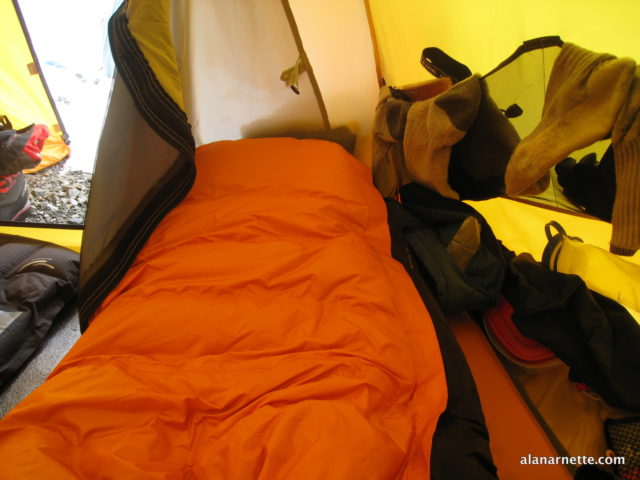
You survey the tent for places to store your collection. The mesh pockets are a great place to hold books, gloves, and a few snacks. The mesh sling attached to the ceiling is a great place for your headlamp that will stay at base camp; you have two more for up high. Slowly you find a home for everything and stuff the now almost empty duffle into the back vestibule. Pulling your -20F down sleeping bag out of its stuff sack, you hope it will loft up before you need it tonight.
The black duffle looks lonely. Great, now you are giving human emotions to your duffle bags. You need coffee.
Wandering over to a huge yellow tent, you walk in, standing up. This is the dining tent where a lot will happen – meals, snacks, conversations, meetings – it’s the town center of your little village.
The long aluminum table has a plastic table cloth that could have come from your great, great Grandmother’s kitchen. The cloth chairs are neatly placed side by side. The plastic yellow and red daisies are a nice touch sitting in the middle of the table next to the Nescafe, Tang, and Oreos. You count the chairs. It matches the number of guides and members. You have a large group, but there are bigger teams.
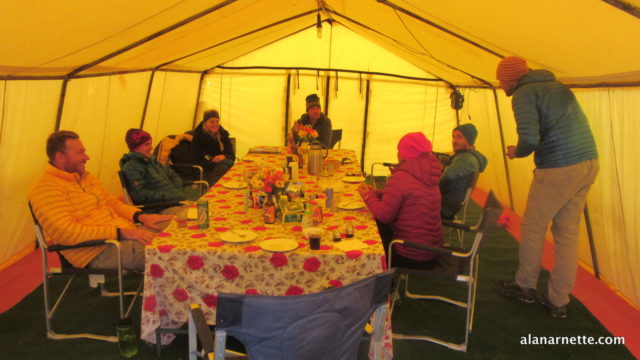
Two stainless steel pitchers are purposefully placed at each end of the table. You grab a ceramic coffee cup, put two scoops of Nescafe in, powder milk, and a bit of sugar before slowly adding hot water from the pitcher. You take your time doing this simple task, not wanting to get out of breath again. Stirring the concoction delivers a coffee smell to the tent. It smells good. The first sip prompts a smile as you sit down at the chair in the middle of the table, just like where your tent is on tent row.
“This is pretty good.” You say again to no one. “Hey mate, how’s the coffee?” says a familiar voice. Glancing over, it’s one of the guides. He’s a Kiwi. “Not bad.” You reply as he makes his own brew and sits across the table. “So how’s your tent?”
Nepal Permit Update
The permits for Everest have picked up as expected but I not anticipating a significant further increase. I’m looking at between 250 and 300 total foreign permits issued. 2021 was a record year with 408 permits issued to foreigners. The Nepal Ministry of Tourism posted these foreign permit tally as of April 13, 2022
- Everest: 250 on31 teams (25-30 teams with between 250-300 members expected)
- Lhotse: 81 on 9 teams
- Nuptse: 38 on 5 teams
- Manaslu: 9 on 1 team
- Annapurna: 26 on 4 teams
- Dhaulagiri: 27 on 3 teams
- Pumori: 0 on 0 team
- Makalu: 39 on 4 teams
- Ama Dablam: 65 on 6 teams
- Gangapurna: 2 on 1 team
- Himlung: 31 on 3 teams
- Thapa (Dhampus): 10 on 3 team
- Bhemdang: 8 on 1 team
- Pokhar Kang: 9 on 1 team
- Urknmang: 2 on 1 team
The Podcast on alanarnette.com
You can listen to #everest2022 podcasts on Spotify, Apple Podcast, Google Podcasts, Pocket Casts, RadioPublic, Anchor, and more. Just search for “alan arnette” on your favorite podcast platform.
Climb On!
Alan
Memories are Everything
Summit Coach
If you dream of climbing mountains but are not sure how to start or reach your next level from a Colorado 14er to Rainier, Everest, or even K2, we can help. Summit Coach is a consulting service that helps aspiring climbers throughout the world achieve their goals through a personalized set of consulting services based on Alan Arnette’s 25 years of high altitude mountain experience, including summits of Everest, K2, and Manaslu, and 30 years as a business executive.

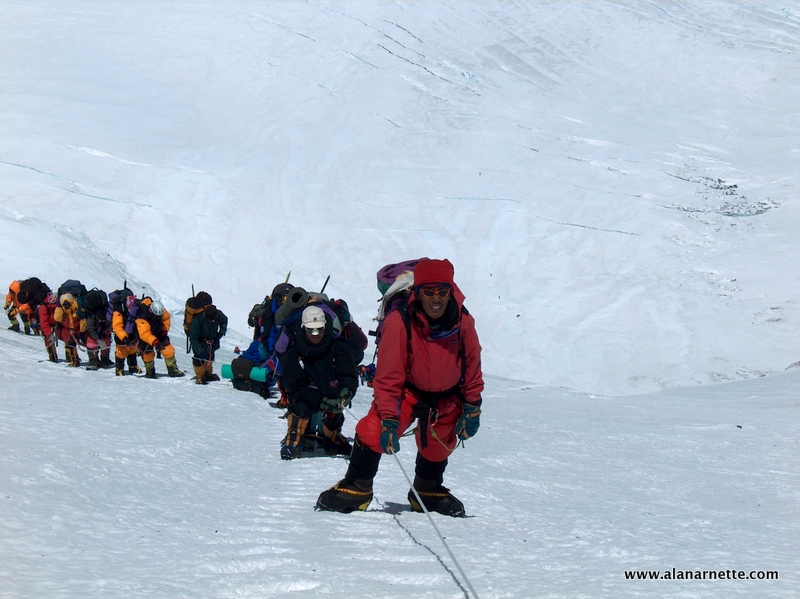
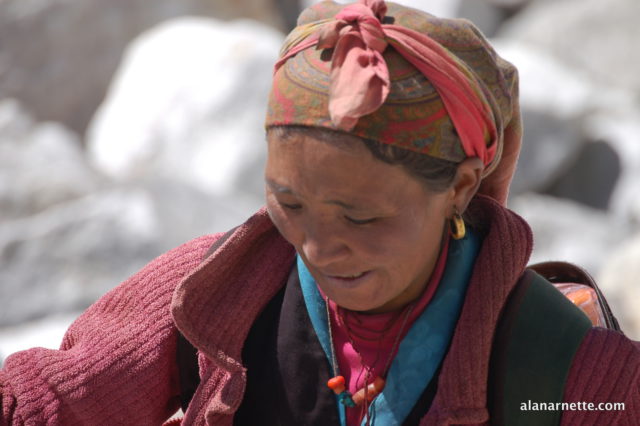
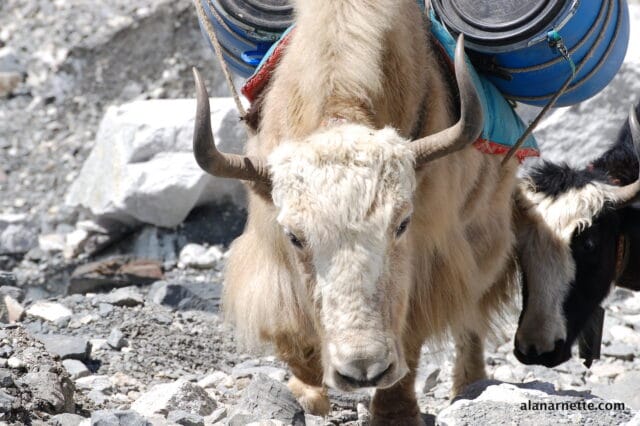
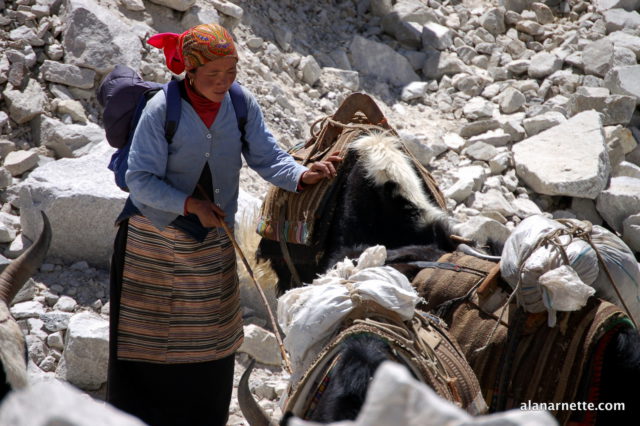
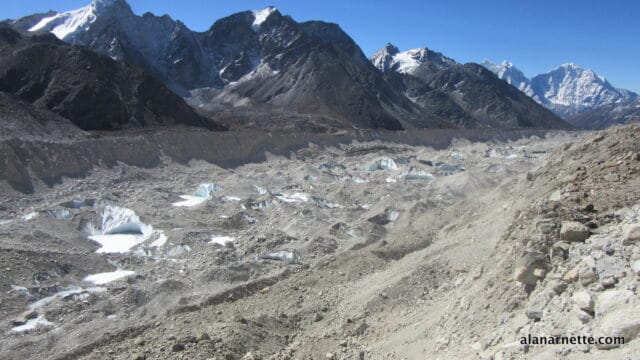
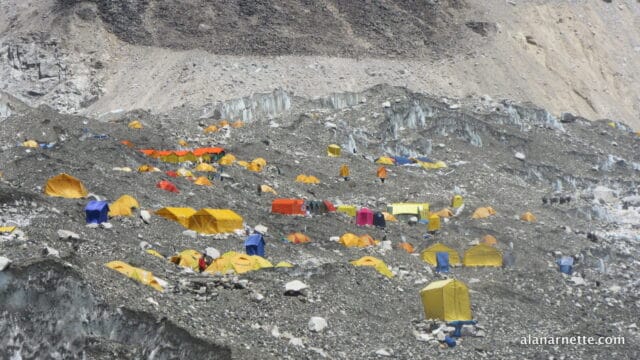
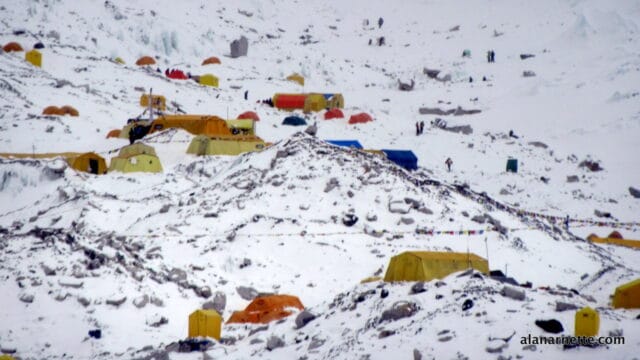
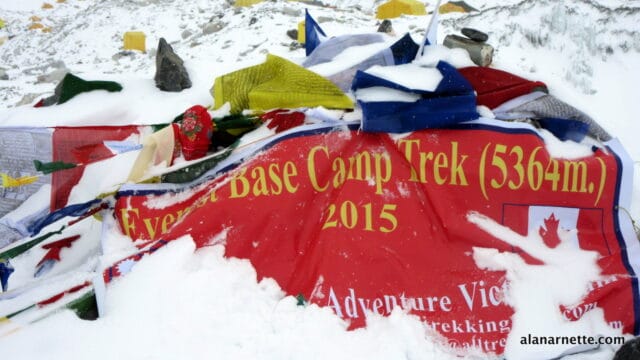

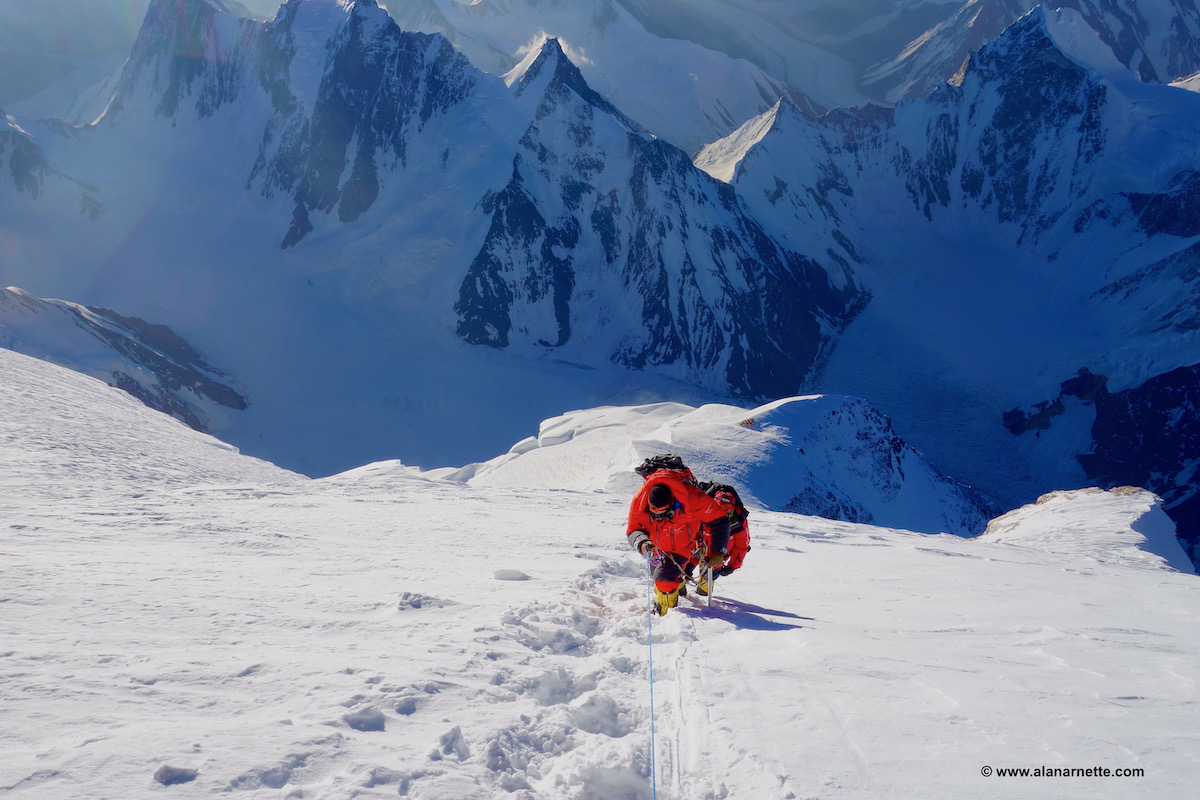

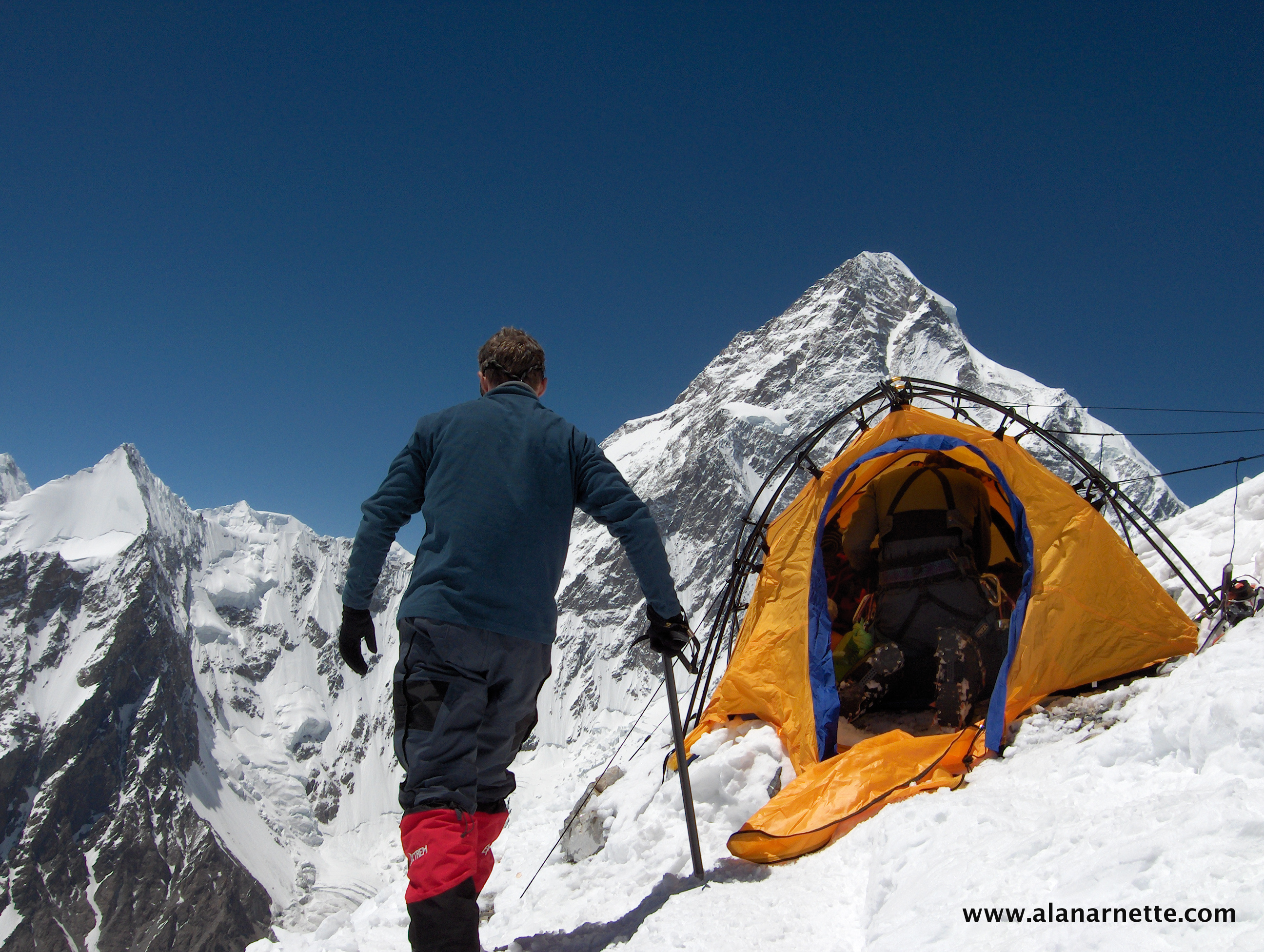
3 thoughts on “Everest 2022: Sherpa Death on Everest”
I’ve never wanted to climb but I love following those who do. My sympathies with the family and team of the Sherpa who passed. Looking forward to this season’s climbs and hope all goes well with everyone.
How sad and surprising about Nima Tenji Sherpa. My condolences to his family, friends, and coworkers.
Thanks for all the work you do with these updates Alan.
Comments are closed.